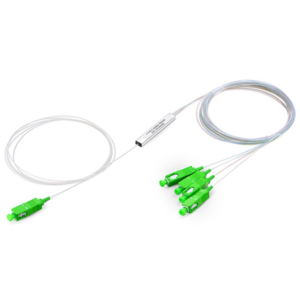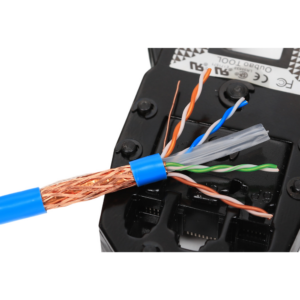Optical module technology undoubtedly plays an important role in high-speed networks. This article will explore the compatibility of SFP28 and QSFP+ optical modules. We will first define the technical standards of SFP28 and QSFP+ optical modules and compare the differences between the two types of optical modules in terms of physical size, port density, etc. Next, we will explore the compatibility of the two types of optical modules from the aspects of interface and optical characteristics, and explain whether SFP28 optical modules can be directly inserted into QSFP+ ports.
We will introduce the method of using patch cords/adapters to achieve compatibility and describe the details of the interconnection of the two types of optical modules by software and hardware. In addition, we will list typical network environments suitable for such interconnection and explain the technical issues that need to be paid attention to during the interconnection process.
Concepts of SFP28 and QSFP+ optical modules
Let me give you a detailed introduction to the basic concepts of SFP28 and QSFP+ optical modules.
Technical standards of SFP28 and QSFP+ optical modules:
(1) SFP28 optical module
- SFP28 is a standard specification for Ethernet interfaces, officially released in 2015.
- It is developed based on the SFP (Small Form Factor Pluggable) interface and supports a transmission rate of 25Gbps.
- The size of the SFP28 optical module is compatible with that of the SFP and can be applied to interfaces such as 100GbE and 40GbE.
(2) QSFP+ optical module
- QSFP+ is a quad-channel small form factor pluggable interface standard, launched in 2006.
- It uses four data channels, each with a maximum rate of 10Gbps and a total rate of 40Gbps.
- QSFP+ optical modules are widely used in 40GbE and 100GbE Ethernet interfaces.
In general, SFP28 and QSFP+ are both high-speed optical module standards, but the former supports a single channel of 25Gbps, while the latter supports a 4-channel 40Gbps transmission rate.
The differences between the two types of optical modules in terms of physical size and port density:
(1) Physical size
- The SFP28 optical module is consistent with the size of the SFP, with a smaller size and a length of only 57mm.
- The QSFP+ optical module is slightly larger, with a length of about 72mm and a width of about 18.35mm.
(2) Port density
- SFP28 is a single-channel interface, generally used for devices equipped with a single fiber interface.
- QSFP+ is a 4-channel interface that can provide higher port density for upper devices.
- Within the same chassis space, the layout of the QSFP+ interface is usually more compact than that of the SFP28.
(3) Power consumption
- The power consumption of the SFP28 optical module is relatively low, with a typical value of about 1-3W.
- QSFP+ optical modules have a relatively high power consumption due to the larger number of channels, usually 3-6W.
In general, the SFP28 optical module supports 25Gbps high-speed transmission with a smaller size and lower power consumption, and is suitable for devices that require high-density interfaces. QSFP+ can provide higher port aggregation capabilities and is more suitable for network devices that require high bandwidth, such as backbone routers.
Compatibility Analysis of SFP28 and QSFP+ Optical Modules
Let me analyze the compatibility of SFP28 and QSFP+ optical modules in terms of interfaces, optical characteristics, etc.
From the perspective of interface compatibility:
- The physical interface size of the SFP28 optical module is fully compatible with the SFP and can be directly inserted into the SFP28 or SFP port.
- The QSFP+ optical module uses a different physical interface size and cannot be directly inserted into the SFP28 or SFP port.
From the perspective of optical characteristic compatibility:
- The optical parameters of the SFP28 optical module, such as operating wavelength and optical power, are basically the same as those of the SFP optical module.
- The optical parameters of the QSFP+ optical module are different, mainly reflected in the design of 4 fiber channels.
In summary, SFP28 optical modules can be directly inserted into SFP28 or SFP ports, but cannot be inserted into QSFP+ ports. QSFP+ optical modules cannot be directly inserted into SFP28 or SFP ports. However, there are some compatible devices that can achieve conversion between SFP28 and QSFP+:
Adapter
- There are special SFP28 to QSFP+ adapter products on the market.
- Through the adapter, SFP28 optical modules can be inserted into QSFP+ ports.
Packaged optical modules
- Some suppliers provide 40GbE QSFP+ optical modules, which integrate 4 25GbE SFP28 modules.
- This type of module can achieve interoperability between SFP28 and QSFP+.
It should be noted that when using adapters or packaged modules, it is necessary to ensure that the optical characteristics, working environment and other parameters are completely matched, otherwise the transmission performance may be affected. In short, as different optical module standards, SFP28 and QSFP+ have certain limitations in direct compatibility, but through appropriate conversion equipment, the two can still achieve interoperability. This is an important factor to consider when designing a network.
Technical solutions for interconnecting SFP28 and QSFP+
Let me introduce you to several technical solutions for interconnecting SFP28 and QSFP+ in detail.
Use adapters/adapters to achieve compatibility:
(1) SFP28 to QSFP+ adapter
- This adapter has an SFP28 interface on one end and a QSFP+ interface on the other end.
- Necessary signal conversion and channel multiplexing are performed internally to achieve interconnection between SFP28 and QSFP+.
- Using this adapter, you can simply insert an SFP28 optical module into a QSFP+ port.
(2) QSFP+ to SFP28 adapter
- This is an intermediate conversion device with a QSFP+ interface on one end and four SFP28 interfaces on the other end.
- The QSFP+ channel is decomposed into four SFP28 signals internally to achieve bidirectional conversion.
- Using this adapter, you can connect a QSFP+ device to an SFP28 interface device.
This patch cord and adapter solution is flexible and convenient, and is the most direct solution for SFP28 and QSFP+ interconnection. However, you need to pay attention to the compatibility and performance indicators of the conversion device.
Software and hardware methods realize the interconnection of two types of optical modules:
(1) Hardware aggregation method
- Configure a dedicated QSFP+ to SFP28 aggregation port on the device.
- The internal ASIC chip multiplexes the QSFP+ channel into 4 SFP28 channels.
- Users can directly insert the SFP28 module into the aggregation port to achieve interconnection with the QSFP+ device.
(2) Software virtualization method
- On devices that support virtualization, virtual SFP28 ports can be created.
- These virtual ports are mapped to the actual QSFP+ physical ports on the device.
- Users can use SFP28 modules on virtual SFP28 ports to interconnect with QSFP+ devices.
This hardware aggregation or software virtualization method can better shield the differences between SFP28 and QSFP+ and provide users with a unified interface. However, the device itself needs to have the corresponding hardware and software support capabilities. Regardless of the solution used, when implementing the interconnection between SFP28 and QSFP+, it is necessary to ensure that the working parameters and optical characteristics of the two optical modules are fully compatible to ensure the reliability and performance of network transmission.
Application scenarios and precautions of SFP28 and QSFP+ interconnection
Let me summarize the typical scenarios and relevant precautions of SFP28 and QSFP+ interconnection technology in actual applications.
Typical network environments suitable for SFP28 and QSFP+ interconnection:
(1) Data center network
- A large number of high-speed Ethernet devices are used in data centers, requiring a large number of 25G and 40G ports.
- Through SFP28 and QSFP+ interconnection technology, high-speed interconnection between devices with different interfaces can be achieved.
(2) Carrier backbone network
- Core devices such as routers and switches in carrier networks mostly use QSFP+ interfaces.
- By converting from SFP28 to QSFP+, high-speed access devices can be seamlessly connected to the backbone network.
(3) High-performance computing environment
- High-performance computing clusters usually require large-bandwidth interconnection, and the QSFP+ interface is suitable for such scenarios.
- Equip the computing node with an SFP28 optical module, and then use the conversion device to achieve interconnection with the QSFP+ device.
Technical issues that need to be paid attention to during the interconnection between SFP28 and QSFP+:
(1) Optical property matching
- Ensure that the optical parameters such as optical power and wavelength of SFP28 and QSFP+ modules are fully compatible.
- Otherwise, the link performance may be degraded or even unable to communicate.
(2) Signal integrity
- When using a patch cord/adapter, pay attention to maintaining signal integrity.
- If severe distortion occurs during the conversion process, the transmission quality will be affected.
(3) Port layout
- QSFP+ interfaces usually take up more chassis space, so it is necessary to plan the equipment layout reasonably.
- If a large number of converters are used, the efficiency of cabinet use may be affected.
(4) Power consumption and heat dissipation
- QSFP+ modules consume more power than SFP28 modules, which places higher requirements on the power supply and heat dissipation capabilities of the equipment.
- The overall power consumption and heat dissipation of the converter and the equipment behind it need to be evaluated.
(5) Performance loss
- The interconnection between SFP28 and QSFP+ through conversion equipment may cause certain performance loss.
- The actual transmission rate, delay and other performance indicators need to be evaluated to ensure that business needs are met.
In short, the interconnection between SFP28 and QSFP+ is a widely used technology, but in the implementation process, it is necessary to fully consider optical, electrical, layout and other factors to ensure the reliability and performance of the interconnection solution.
Summary
The reasonable interconnection between SFP28 and QSFP+ optical modules is crucial for the construction of high-speed networks. Our company has long been focusing on the research and development and production of optical communication equipment and its supporting products, and has rich industry experience. Our SFP28 and QSFP+ optical module interconnection solutions have reached the industry-leading level in terms of compatibility and reliability, and can meet your demanding needs for flexible and efficient network architecture.
Whether you need to deploy this type of interconnection in a telecom operator network, data center, or enterprise campus, we can provide you with customized solutions. At the same time, our professional team will provide you with a full range of technical support, including on-site surveys, solution design, and equipment installation and maintenance. Contact us now to learn more about SFP28 and QSFP+ optical module interconnection.
SFP28 & QSFP+ Compatibility FAQ
SFP28 is a 25 Gigabit Ethernet (25GbE) transceiver module that uses the small form-factor pluggable (SFP) interface.
QSFP+ is a 40 Gigabit Ethernet (40GbE) and 4x10GbE transceiver module that uses the quad small form-factor pluggable (QSFP) interface.
No, SFP28 optical modules are not directly compatible with QSFP+ ports. The physical form factors are different.
Yes, you can use a breakout cable or adapter to connect individual SFP28 modules to QSFP+ ports, but this may result in reduced performance.
When using an SFP28 module in a QSFP+ port via an adapter, the maximum supported data rate is typically 10GbE, not 25GbE.
Yes, some vendors offer SFP28 to QSFP+ converter modules that enable 25GbE connectivity over QSFP+ ports.
Yes, using a converter may limit the capabilities of the SFP28 module, such as reducing the maximum supported cable length.
Native SFP28 ports are generally preferred for 25GbE networks, as they will provide the best performance and reliability.
Besides the physical form factor, SFP28 and QSFP+ transceivers use different power, signaling, and cabling specifications.
This may be necessary when upgrading existing QSFP+ equipment to support 25GbE, but should be considered a temporary or legacy solution.



